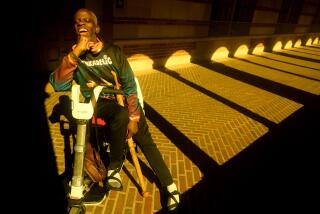O.C. Teens Aid U.S. Study on Adult-Onset Diabetes
- Share via
Soothing Chelsea Salzman while they drew her blood was a group effort: One nurse stroked her arm, her mother shielded her eyes and another nurse tried to distract the 13-year-old by talking about the beauty of Hawaii.
The San Juan Capistrano eighth-grader sobbed as her blood filled four tubes; still, she said afterward, the ordeal was worth it.
Chelsea, one of about 160 teen volunteers at Marco F. Forster Middle School screened for adult-onset diabetes this week as part of a national study, said she hopes the research generated leads to a cure for the disease.
“The opportunity to do something that might help people with diabetes convinced me I needed to psych myself out of being scared,” she said.
In addition to testing how well the kids’ bodies process sugar -- more blood was drawn after they consumed a syrupy glucose drink -- data were gathered on their height, weight, blood pressure and body fat.
Four other Southern California schools -- Lathrop Intermediate in Santa Ana, two in Pomona and one in Hemet -- are participating in the study, funded by the National Institutes of Health to gauge how much childhood obesity has boosted the rate of Type 2 diabetes.
UC Irvine and University of Southern California medical researchers are studying about 700 students. Some 800 more will be tested by the University of North Carolina and Baylor University in Houston.
Schools with large minority populations were approached to participate, since adult-onset diabetes disproportionately strikes Latinos, blacks and Native Americans. In the past 15 years, as the number of overweight teens has tripled, doctors have seen a corresponding increase in the number of kids suffering the sort of health problems associated with middle-aged adults.
Few statistics have been gathered about how many children are being diagnosed with adult-onset diabetes, since it’s a relatively recent phenomenon, but clinicians have reported that the number of children they see with the disease has doubled in the last five years.
Unless kids significantly alter their diets and how much they exercise, the problem will continue to get worse, said Dr. Dan Cooper, principal investigator for the Southern California study. “You have to catch them early if you want to change their lives,” he said.
Researchers hope the study will generate information on preventing and treating Type 2 diabetes in children that can be used to influence school nutrition and physical education policies.
A pilot P.E. program will be tested in the study’s second year at several schools. Direct-intervention programs will follow in the third year.
Marco Forster Principal Jim Sieger said the screening was a chance to provide potentially life-changing medical information to his students.
“If there’s something we can do to head off a lot of problems for these kids later,” he said, “it’s a great thing.”
Researchers, who will learn the results two to three days after the blood is tested, will pass that information on to parents.
Follow-up meetings are scheduled for those teens who test positive for diabetes -- so far, two undiagnosed cases have been found in the Southern California screenings -- or prediabetes. So far in the state trials, about 7% of the kids showed difficulty processing sugar but had not developed full-blown diabetes. Exercise and a change in diet can prevent prediabetes from becoming adult-onset diabetes.
Along with consultations, researchers work with parents to make sure they know about available resources.
“Our follow-up isn’t just, ‘Here’s a pamphlet, good luck,’ ” said Stan Bassin, a UCI cardiology researcher. “The really important thing is education.”
Each morning for the past week, Marco Forster’s multipurpose room was transformed into a health clinic, cloth partitions separating 20 data-collection stations.
After signing in and having numbing cream applied, the kids chatted nervously.
The blood drawing, while frightening for Chelsea and three girls who threw up Friday, was painless for most. Ellen Bobchin, a nurse who usually works in UCI Medical Center’s emergency room, kept up a steady banter to relax the kids who came through her station.
Students discussed what they would do with their participation incentive: a $50 certificate for the Shops at Mission Viejo.
To Janine Salzman, learning more about Chelsea’s health was the main point of the screening.
“This is a chance to get a heads-up” if her daughter has diabetes, she said. “With all the sugar kids have these days, it’s amazing they all don’t have it.”






